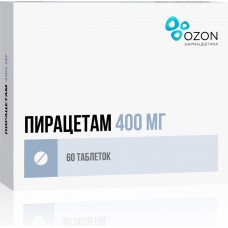Expiration date: 11/2027
Release form
tablets, capsules
Composition
active substance: piracetam — 200, 400, 800 or 1200 mg.
Packaging
20, 30 or 60 PCs.
Pharmacological action
Piracetam activates in the Central nervous system associative processes, improves mood, memory and mentality of patients and healthy people. Stimulates intellectual activity and integrative activity of the brain, facilitates learning, improves communication between the cerebral hemispheres and the synaptic conductance in the cortex, improves mental capacity, stabilizes and restores the impaired functions of the brain (memory, consciousness, speech). Piracetam normalizes the ratio of ADP and ATP (inhibits nucleotidases and activates adenylate cyclase) that increases the activity of phospholipase A, stimulates in nervous tissue plastic and bioenergetic processes and metabolism of neurotransmitters.
Piracetam increases the stability of brain tissue to toxic effects and hypoxia increases the synthesis of phospholipids and nuclear RNA, enhances the glycolytic processes and the utilization of glucose in the brain. Piracetam inhibits platelet aggregation, improves microcirculation, optimizes the ability of erythrocytes to pass through the microvasculature and conformational properties of membranes of red blood cells in the ischemic areas of the brain increases regional blood flow. Piracetam increases in EEG alpha and beta activity and lower Delta activity. Reduces the vestibular nystagmus. During hypoxia, intoxication, trauma, electroconvulsive effects has a neuroprotective effect.
In connection with the anti-hypoxic effect of piracetam is effective in treatment of myocardial infarction. Anxiolytic and sedative effects of piracetam available.
Is almost completely and rapidly piracetam is absorbed after ingestion. The bioavailability is 100%. The ingestion of 2 g of the drug maximum plasma concentration is 40-60 µg/ml in 30 minutes. Piracetam is not bound to plasma proteins. Over 2-8 hours it creates the maximum concentration in the liquor. Piracetam penetrates into all tissues and organs, penetrates through the placental barrier. Almost not metabolized. Selectively accumulates in the cerebral cortex, mainly in parietal, frontal and occipital lobes, basal ganglia and cerebellum. The half-life of piracetam in plasma is equal to 4-5 hours, from cerebrospinal fluid is 6-8 hours. More than 95% of drug is excreted unchanged by the kidneys after 30 hours. In patients with renal insufficiency the elimination half-life increases.
Testimony
- Chronic cerebrovascular insufficiency (hypertension, atherosclerosis, vascular parkinsonism), which is accompanied by disturbance of attention, memory, speech, headache and dizziness,
- ischemic stroke and its consequences,
- psycho-organic disorders,
- dementia (senile dementia, Alzheimer's disease, vascular dementia),
- traumatic brain injury,
- acute viral neuroinfection,
- intoxication (recovery period, coma and subcomittee state),
- diseases of the nervous system, which are accompanied by decrease in level of wakefulness, of intellectual-mnestic functions, behavioral disorders and emotional-volitional sphere,
- dizziness,
- vestibular nystagmus
- sluggish-apathetic state,
- aphasia,
- cortical myoclonia,
- epilepsy (as adjuvant),
- senile and atrophic processes
- depression resistant to antidepressant treatment
- the prevention or elimination of neurological, somatic and vegetative, psychiatric complications of treatment with neuroleptics and other psychotropic drugs,
- neurotic depression with a predominance in the clinical picture, senesta-hypochondriacal and asthenic disorders, weakness, phenomena of ideomotor retardation,
- psychoorganic syndrome in chronic alcoholism,
- relief pre - and delirious, withdrawal state when drug addiction and alcoholism,
- acute intoxication by morphine, ethanol, amphetamine, barbiturates,
- in children with cerebral palsy, consequences of perinatal lesions of the Central nervous system, delayed mental development, low learning ability when psychoorganic syndrome, speech disorder, mental retardation, impaired memory, cerebrasthenia, intellectual disabilities,
- sickle-cell anemia (in the complex treatment).
Contraindications
Hypersensitivity (including to a derivative of pyrrolidone), renal insufficiency (with creatinine clearance less than 20 ml/min), hemorrhagic stroke, Huntington's disease, agitated depression, breast-feeding, pregnancy, age up to 1 year.
Application of pregnancy and breastfeeding
Reception piracetam is contraindicated during pregnancy. During therapy with piracetam, you need to stop breastfeeding because the drug passes into breast milk.
Special instructions
Patients with impaired renal function history of the drug is administered with caution these patients require correction of dosing regimen based on the values of creatinine clearance.
In the case of sleep disorders is recommended to cancel an evening reception of the drug, attaching the dose to day reception.
Piracetam penetrates through the filter membrane devices for hemodialysis.
Use caution when working with machinery.
Method of application and doses
Inside.
During a meal or on an empty stomach, drinking liquid.
Symptomatic treatment psychoorganic syndrome: 2, 4 - 4, 8 g / day 2-3 reception.
Treatment of vertigo and associated imbalance: 2, 4 - 4, 8 g / day 2-3 reception.
Treatment of cortical myoclonia: start with doses of 7, 2 g / day every 3-4 days, increase the dose of 4, 8 g / day to maximum dose of 24 g per day in 2-3 reception. Treatment continued throughout the period of the disease. Every 6 months should attempt dose reduction or discontinuation of the drug, gradually reducing the dose for 1, 2 g / day every 2 days.
Treatment of sickle cell anemia: prophylactic daily dose of 160 mg/kg of body weight divided into 4 equal doses.
Treatment of dyslexia in children (in combination with other treatment methods): the recommended daily dose for children from 8 years and teenagers - 3, 2 g, divided into 2 doses.
Side effects
Nervous system and sense organs: hyperkinesis, drowsiness, irritability, depression, agitation, asthenia, aggressive behavior, dizziness, sleep disorder, headache, tremor, increased sexuality,
Digestive system: nausea, diarrhea, vomiting, abdominal pain,
Metabolism: increased body weight,
The circulatory system: the aggravation of coronary insufficiency, hypertension or hypotension,
Skin: hypersensitivity reactions.
Drug interactions
Piracetam enhances the effects of anticoagulants, stimulants, Central effects of thyroid hormones (anxiety, tremor, sleep disturbance, irritability, confusion). Enhanced the severity of extrapyramidal disorders with coadministration of piracetam with neuroleptics.
Overdose
In case of overdose with piracetam increasing side effects.
Treatment: gastric lavage, reception activated carbon, symptomatic treatment, no specific antidote, possible hemodialysis (efficiency 50-60%).



